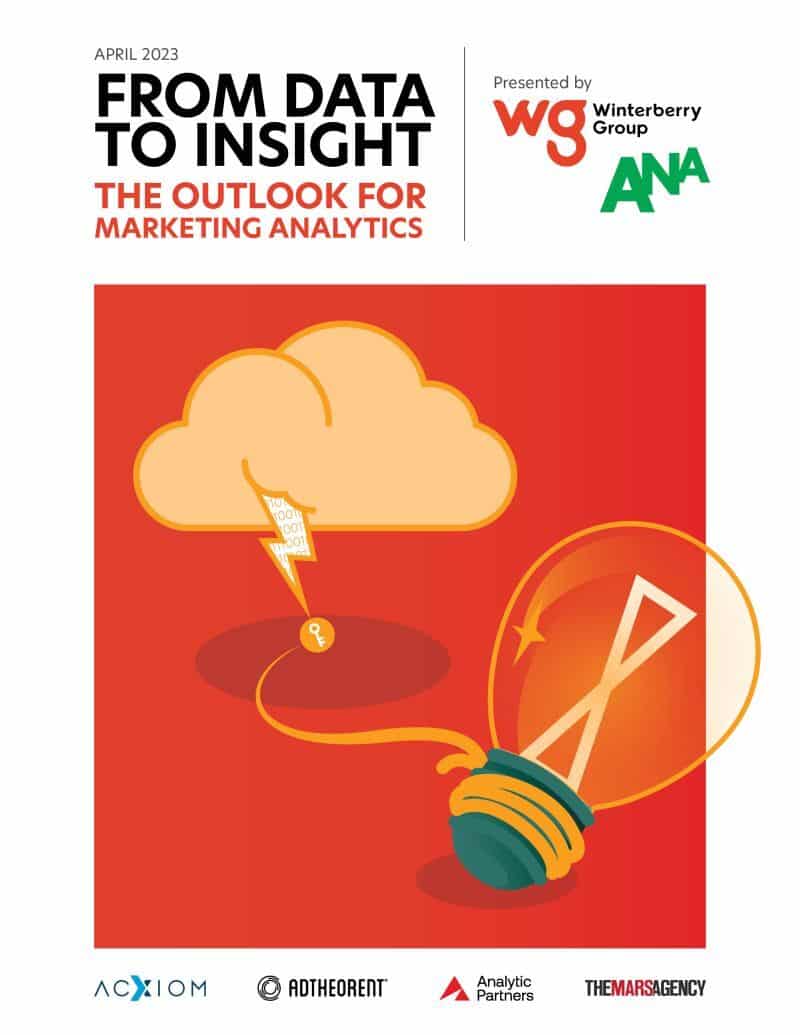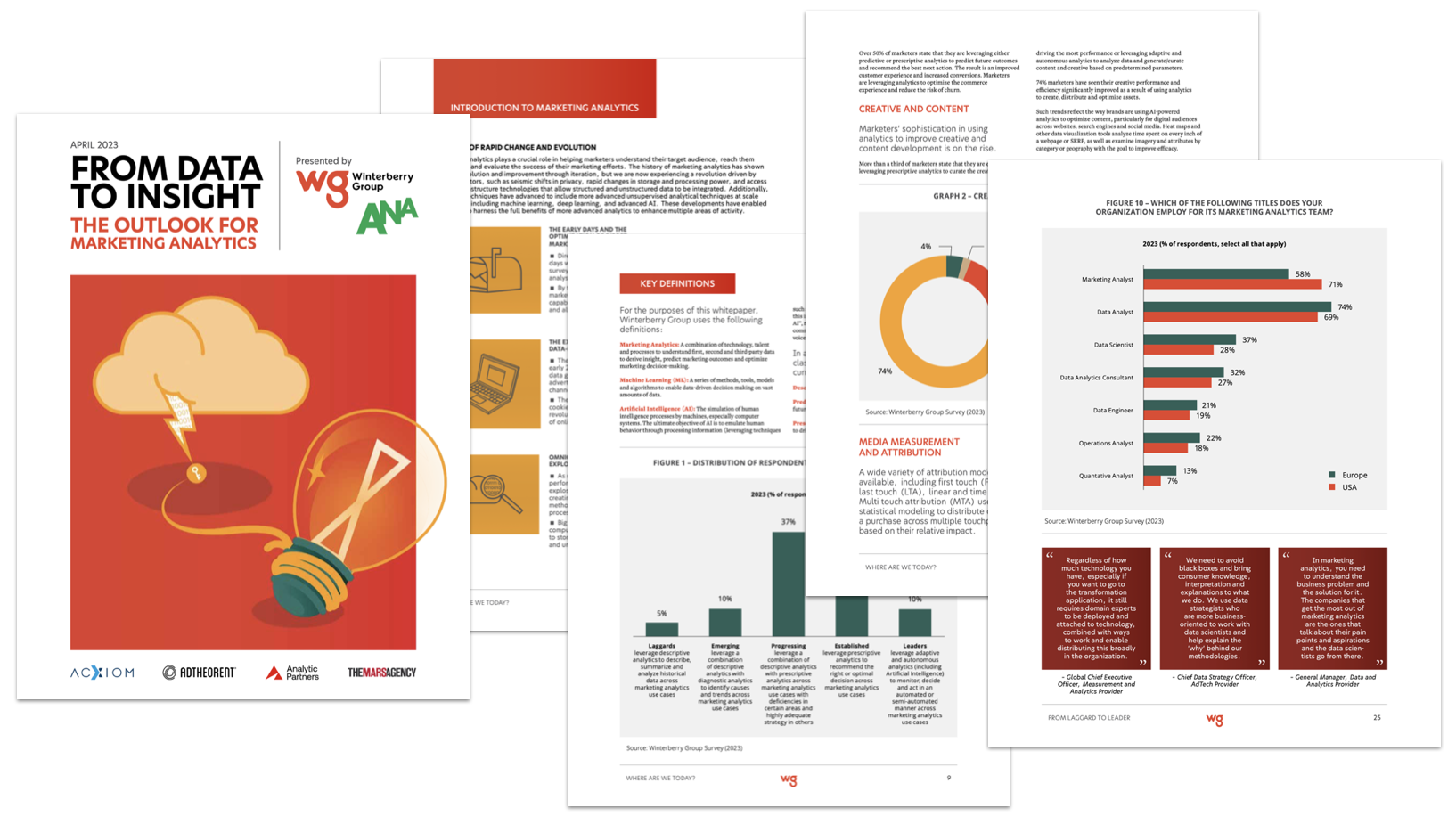As data becomes more readily available to inform personalized and targeted marketing, marketing analytics are top of mind for marketing leaders. Today, marketing analytics use cases are ever-expanding, driven by technological advances, an increase in consumer touch points, and the desire to use data to make faster, better decisions.
But, as data privacy standards and regulations continue to evolve, many marketers struggle to keep up with marketing analytics trends and best practices. Between cumbersome technology, confusing compliance standards and internal hurdles, data-powered marketing still feels unattainable to many marketers.
To better understand the growing marketing analytics landscape, Aqfer teamed up with the data strategy pros at Winterberry Group to develop a study of the outlook for marketing analytics. The study, run from February to March 2023, surveyed 204 C-suite, director and VP-level marketers across the US and Europe. The research included a quantitative survey plus 25 interviews with marketing leaders.
From Data to Insight: The Outlook on Marketing Analytics – Highlights & Takeaways
The report, titled “From Data to Insight: The Outlook on Marketing Analytics” is chock full of marketing analytics trends, use cases, and best practices shared by companies who are successfully using data to power their marketing and advertising activity.
Read on for highlights and takeaways from the 34-page report, and click here to download your free copy.
Analytics Maturity Among Marketing Organizations Is a Work in Progress
47% of organizations report themselves as either “emerging” or “progressing”, and only 10% have moved to “leader” status. The research identified maturity levels based on the complexity and type of use cases for which the organization leverages analytics. The results indicate that most marketers have evolved beyond descriptive analytics and are now leveraging predictive and prescriptive analytics to drive decision-making – with European marketers evolving more rapidly as a result of limits on data availability.
Spend On Marketing Analytics and Data Infrastructure will Reach $32B by 2026
Spending on data and analytics infrastructure is expected to grow at a CAGR of 10% from $22 billion in 2022 to $32 billion in 2026 in the US, UK, and EU. Technological advancements and process improvements have enabled businesses to achieve more with less reliance on people, empowering business analysts and engineers to leverage readily available technology, while reducing reliance on individuals with advanced degrees and offshore talent.
Data Aggregation, Quality and Security Lead Analytics- Related Spending Priorities
Both US and EU marketers have identified data aggregation from multiple sources, data quality and data security as priority investment areas to improve the effectiveness of their analytics efforts. Other spending priorities include investments in data management technology and selecting the right analytics tools.
Using Analytics to Improve Creative and Content Development is a Fast-Growing Area
Marketers’ sophistication in using analytics to improve creative and content development is growing rapidly and approaching a key inflection point. Analytics are helping to drive evidence-based creative decisions that are increasing customer engagement and conversion rates. More than one third of survey respondents said they were either leveraging prescriptive analytics to curate the creative assets driving the most performance or leveraging adaptive and autonomous analytics to analyze data and generate/curate content and creative based on predetermined parameters. This will accelerate very rapidly as generative AI matures into embedded solutions.
Media Measurement And Attribution Is a Priority, and a Challenge
Media measurement and attribution is one of the most prevalent areas for marketing analytics, despite the challenges posed by cookie deprecation, the resulting lack of standard identifiers and the growing number of data privacy regulations. The future state solution will most likely involve elements of econometrics-based marketing mix modeling, as well as deterministic and model-based attribution solutions from a range of open and closed sources.
The Skills Gap is a Challenge, but its Impact is Weakening
As technology adoption spreads, critical challenges inhibiting analytics maturity include the lack of centralization of the analytics function across the organization and the lack of talent availability. Ultimately the difference between the leaders and those who are emerging or lagging is a skills gap, one that will take a concerted investment in the benefits of analytics in driving outcomes to resolve. Meanwhile, nearly 75% of all respondents are leveraging third party provider support to bridge the gap.
Download Your Free Copy of The Research
This research is foundational to further developing marketing analytics capabilities and we are thrilled to share it with you. Get inspired by global marketing leaders who are successfully using analytics to drive business outcomes, and get ready to transform your marketing capabilities. Download your copy of the 34-page to get in-depth insights around the current and future state of marketing analytics.



